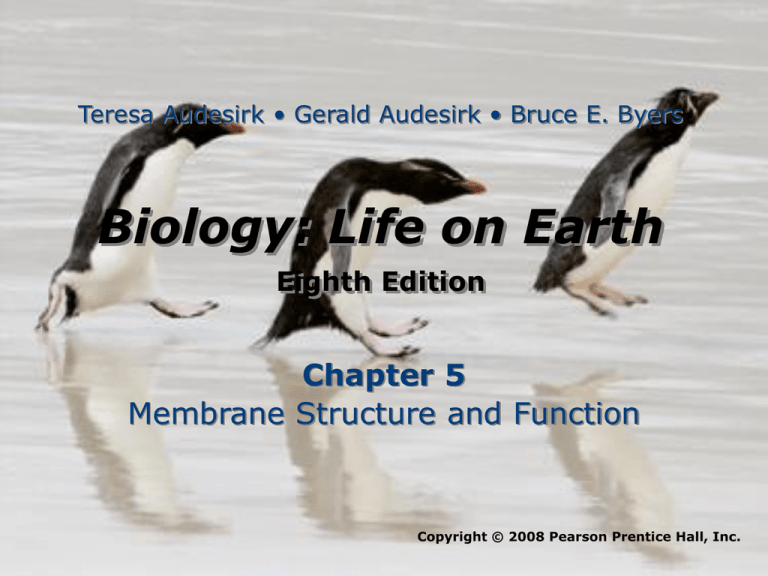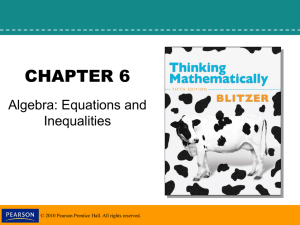
Teresa Audesirk • Gerald Audesirk • Bruce E. Byers
Biology: Life on Earth
Eighth Edition
Chapter 5
Membrane Structure and Function
Copyright © 2008 Pearson Prentice Hall, Inc.
Chapter 5 Opener Biology: Life on Earth 8/e ©2008 Pearson Prentice Hall, Inc.
Chapter 5 Opener (inset) Biology: Life on Earth 8/e ©2008 Pearson Prentice Hall, Inc.
extracellular fluid (outside)
carbohydrate
receptor
protein
recognition protein
cholesterol
phospholipid
binding
site
glycoprotein
phospholipid
bilayer
protein
transport
pore protein
protein filaments
cytosol (inside)
Figure 5-1 Biology: Life on Earth 8/e ©2008 Pearson Prentice Hall, Inc.
tails
(hydrophobic)
head
(hydrophilic)
Figure 5-2 Biology: Life on Earth 8/e ©2008 Pearson Prentice Hall, Inc.
extracellular fluid
(watery environment)
hydrophilic
heads
phospholipid
hydrophobic
tails
bilayer
hydrophilic
heads
cytosol
(watery environment)
Figure 5-3 Biology: Life on Earth 8/e ©2008 Pearson Prentice Hall, Inc.
more fluid
Figure 5-4 Biology: Life on Earth 8/e ©2008 Pearson Prentice Hall, Inc.
less fluid
(outside)
(inside)
reactions
Figure 5-5 Biology: Life on Earth 8/e ©2008 Pearson Prentice Hall, Inc.
1 A drop of dye is
placed in water.
2 Dye molecules
diffuse into the
water; water
molecules diffuse
into the dye.
drop of
dye
water
molecule
Figure 5-6 Biology: Life on Earth 8/e ©2008 Pearson Prentice Hall, Inc.
3 Both dye molecules
and water molecules
Are evenly dispersed.
Table 5-1 Biology: Life on Earth 8/e ©2008 Pearson Prentice Hall, Inc.
(a) Simple diffusion through the phospholipid bilayer
lipid-soluble molecules (extracellular fluid)
and O2, CO2, H2O
O2
(cytosol)
Figure 5-7a Biology: Life on Earth 8/e ©2008 Pearson Prentice Hall, Inc.
(b) Facilitated diffusion through a channel protein
Cl–
H2O,
ions
Cl–
Proteins form a
hydrophilic channel.
Cl–
Cl–
channel
protein
Cl–
(cytosol)
Figure 5-7b Biology: Life on Earth 8/e ©2008 Pearson Prentice Hall, Inc.
(c) Facilitated diffusion through a carrier protein
carrier
protein
amino acids,
sugars, small
proteins
(extracellular fluid)
(cytosol)
1 Carrier protein
has binding site
for molecule.
2 Molecule
enters binding
site.
3 Carrier protein
changes shape,
transporting
molecule across
membrane.
Figure 5-7c Biology: Life on Earth 8/e ©2008 Pearson Prentice Hall, Inc.
4 Carrier protein
resumes original
shape.
isotonic: no net
flow of water
Figure 5-8 Biology: Life on Earth 8/e ©2008 Pearson Prentice Hall, Inc.
Figure E5-1 Biology: Life on Earth 8/e ©2008 Pearson Prentice Hall, Inc.
egg without
aquaporins
Figure E5-2a Biology: Life on Earth 8/e ©2008 Pearson Prentice Hall, Inc.
egg with
aquaporins
extracellular
fluid
water
aquaporin
channel
cytosol
water
Figure E5-2b Biology: Life on Earth 8/e ©2008 Pearson Prentice Hall, Inc.
Figure 5-9 Biology: Life on Earth 8/e ©2008 Pearson Prentice Hall, Inc.
(a) Isotonic
solution
Equal movement
of water into and
out of cells.
(b) Hypertonic
solution
Net water
movement
out of cells.
Figure 5-10 Biology: Life on Earth 8/e ©2008 Pearson Prentice Hall, Inc.
(c) Hypotonic
solution
Net water
movement
into cells.
cytosol
central
vacuole
cell wall
When water is
plentiful, it fills the
central vacuole,
pushes the cytosol
against the cell wall,
and helps maintain
the cell's shape.
Water pressure
supports the leaves
of this impatiens
plant.
Figure 5-11 Biology: Life on Earth 8/e ©2008 Pearson Prentice Hall, Inc.
plasma
membrane
When water is scarce,
the central vacuole
shrinks and the cell
wall is unsupported.
Deprived of the
support from water,
the plant wilts.
cytosol
central
vacuole
When water is plentiful, it fills the central
vacuole, pushes the cytosol against the cell
wall, and helps maintain the cell's shape.
Figure 5-11 (part 1) Biology: Life on Earth 8/e ©2008 Pearson Prentice Hall, Inc.
Water pressure supports the leaves
of this impatiens plant.
Figure 5-11 (part 2) Biology: Life on Earth 8/e ©2008 Pearson Prentice Hall, Inc.
cell wall
plasma
membrane
When water is scarce, the central vacuole
shrinks and the cell wall is unsupported.
Figure 5-11 (part 3) Biology: Life on Earth 8/e ©2008 Pearson Prentice Hall, Inc.
Deprived of the support from
water, the plant wilts.
Figure 5-11 (part 4) Biology: Life on Earth 8/e ©2008 Pearson Prentice Hall, Inc.
1 The transport protein
binds both ATP and Ca2+.
2 Energy from ATP
Changes the shape of
the transport protein
and moves the ion
across the membrane.
3 The protein releases
the ion and the remnants
of ATP (ADP and P) and
closes.
(extracellular fluid)
ATP
ATP
recognition
site
Ca2+
ADP
(cytosol)
ATP
binding
site
Figure 5-12 Biology: Life on Earth 8/e ©2008 Pearson Prentice Hall, Inc.
P
(a) Pinocytosis
(extracellular fluid)
1
3
2
(cytosol)
vesicle containing
extracellular
fluid
1 A dimple forms in the plasma membrane, which 2 deepens
and surrounds the extracellular fluid. 3 The membrane
encloses the extracellular fluid, forming a vesicle.
Figure 5-13a Biology: Life on Earth 8/e ©2008 Pearson Prentice Hall, Inc.
(b) Pinocytosis in a smooth muscle cell.
1
extracellular fluid
2
cytosol
Figure 5-13b Biology: Life on Earth 8/e ©2008 Pearson Prentice Hall, Inc.
3
Receptor-mediated endocytosis
nutrients
(extracellular fluid)
receptors
coated
pit
1
2
3
(cytosol)
4
coated vesicle
1 Receptor proteins for specific molecules or complexes of molecules are
localized at coated pit sites.
2 A vesicle (“coated vesicle”) containing the bound molecules is released into
the cytosol.
3 The coated pit region of the membrane encloses the receptor-bound
molecules.
4 The receptors bind the molecules and the membrane dimples inward.
Figure 5-14 (part 1) Biology: Life on Earth 8/e ©2008 Pearson Prentice Hall, Inc.
extracellular particles
bound to receptors
coated vesicle
(extracellular fluid)
(cytosol)
1
2
3
4
0.1 micrometer
protein
coating
coated pit
plasma membrane
Figure 5-14 (part 2) Biology: Life on Earth 8/e ©2008 Pearson Prentice Hall, Inc.
(a) Phagocytosis
food particle
pseudopods
1
(cytosol)
(extracellular fluid)
2
food vacuole
3
1 The plasma membrane extends pseudopods toward an
extracellular particle (for example, food). 2 The ends of the
pseudopods fuse, encircling the particle. 3 A vesicle called a
food vacuole is formed containing the engulfed particle.
Figure 5-15a Biology: Life on Earth 8/e ©2008 Pearson Prentice Hall, Inc.
(b) Amoeba
An Amoeba (a freshwater
protist), engulfs a
Paramecium
using phagocytosis.
Figure 5-15b Biology: Life on Earth 8/e ©2008 Pearson Prentice Hall, Inc.
(c) White blood cell
A white blood cell
ingests bacteria using
phagocytosis.
Figure 5-15c Biology: Life on Earth 8/e ©2008 Pearson Prentice Hall, Inc.
secreted
material
plasma
membrane
(extracellular fluid)
vesicle
(cytosol)
Material is enclosed in a vesicle that
fuses with the plasma membrane,
allowing its contents to diffuse out.
Figure 5-16 Biology: Life on Earth 8/e ©2008 Pearson Prentice Hall, Inc.
0.2 micrometer
r
r
distance to center (r)
surface area (4r2)
volume (4/3r3)
surface area/volume
1.0
12.6
4.2
3.0
Figure 5-17 Biology: Life on Earth 8/e ©2008 Pearson Prentice Hall, Inc.
3.0
113.1
4.2
1.0
(a) Desmosome
small intestine
cells lining
small intestine
(b) Tight junction
urinary bladder
cells lining
bladder
microvilli
desmosome
plasma
membranes
(edge view)
Protein strands
hold cells
together.
Tight junctions
formed by
strands of
protein seal
cells together.
protein
filaments in
cytosol
Figure 5-18 Biology: Life on Earth 8/e ©2008 Pearson Prentice Hall, Inc.
(a) Gap junctions
(b) Plasmodesmata
root
liver
liver cells
root cells
plasma
membrane
Gap junctions:
pairs of
channels
connect insides
of adjacent
cells.
Figure 5-19 Biology: Life on Earth 8/e ©2008 Pearson Prentice Hall, Inc.
cell wall
plasma
membrane
Plasmodesmata
connect insides
of adjacent
cells.
Figure 5-20 Biology: Life on Earth 8/e ©2008 Pearson Prentice Hall, Inc.
Figure 5-21a Biology: Life on Earth 8/e ©2008 Pearson Prentice Hall, Inc.
Figure 5-21b Biology: Life on Earth 8/e ©2008 Pearson Prentice Hall, Inc.







